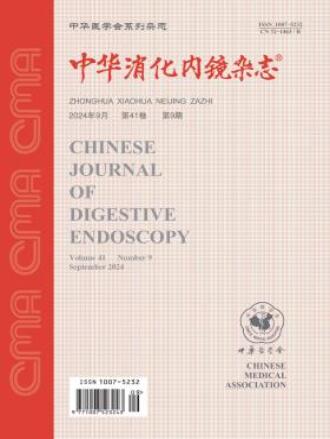Efficacy of hemostatic powder on preventing delayed bleeding after endoscopic submucosal dissection: a randomized controlled trial
引用次数: 0
Abstract
Objective To evaluate the efficacy of hemostatic powder on preventing delayed bleeding after endoscopic submucosal dissection (ESD). Methods Patients who received ESD in the First Affiliated Hospital of Soochow University and Yulin No.2 Hospital from June 2017 to August 2018 were enrolled with informed consents, and randomly divided into the study group and the control group. Hemostatic powder was applied on post-ESD ulcer after routine hemostasis method in the study group, and the control group was given routine hemostasis method only. The time and dosage of hemostatic powder spraying and its adverse events were observed in the study group. The operation time, rate of delayed bleeding (within 30 days after operation) and early delayed bleeding (within 48 hours after operation), and postoperative hospital stay were compared between the two groups. Results A total of 196 patients were enrolled including 97 in the study group and 99 in the control group. The baseline data were comparable between the two groups (all P>0.05). In the study group, the time to spray powder was 68.78±19.75 s, dosage was 2.51±0.93 g. Powder delivery catheter was blocked in one case (1.03%, 1/97). No adverse event was reported during 30 days of follow-up. The operation time was not statistically different in the study group and the control group (61.92±11.71 min VS 59.76±11.01 min, t=1.330, P=0.185). The delayed bleeding rate of the study group was significantly lower than that of the control group [1.03% (1/97) VS 8.08% (8/99), P=0.035]. There was no case of early delayed bleeding occurred in the study group, while 6 cases (6.06%, 6/99) in the control group (P=0.029). The postoperative hospital stay was not statistically different between the study group and the control group (4.57±0.85 d VS 4.86±1.37 d, t=1.778, P=0.077). Conclusion Although capacity of hemostatic system remains to be improved, hemostatic powder is an effective, safe and simple method to reduce delayed bleeding rate after ESD, especially on early delayed bleeding. Key words: Randomized controlled trial; Endoscopic submucosal dissection; Delayed bleeding; Hemostatic powder止血粉预防内镜黏膜下剥离术后延迟出血的疗效:一项随机对照试验
目的评价止血粉预防内镜下黏膜下剥离术后延迟出血的疗效。方法将2017年6月至2018年8月在东吴大学附属第一医院和榆林市第二医院接受ESD治疗的患者纳入知情同意书中,随机分为研究组和对照组。研究组采用常规止血法对ESD后溃疡涂止血粉,对照组仅采用常规止血方法。观察研究组止血粉喷洒时间、剂量及不良反应。比较两组的手术时间、术后30天内延迟出血率、术后48小时内早期延迟出血率及术后住院时间。结果共有196例患者入选,其中研究组97例,对照组99例。两组的基线数据具有可比性(均P>0.05)。研究组喷洒粉末的时间为68.78±19.75s,剂量为2.51±0.93g。1例(1.03%,1/97)粉末输送导管堵塞。随访30天内未报告不良事件。研究组和对照组的手术时间无统计学差异(61.92±11.71分钟VS 59.76±11.01分钟,t=1.330,P=0.015)。研究组的延迟出血率显著低于对照组[1.03%(1/97)VS 8.08%(8/99),P=0.035],对照组6例(6.06%,6/99)(P=0.029)。研究组与对照组术后住院时间无统计学差异(4.57±0.85 d VS 4.86±1.37 d,t=1.778,P=0.077),尤其是早期延迟出血。关键词:随机对照试验;内镜黏膜下剥离术;延迟出血;止血粉
本文章由计算机程序翻译,如有差异,请以英文原文为准。
求助全文
约1分钟内获得全文
求助全文
来源期刊
CiteScore
0.10
自引率
0.00%
发文量
7555
期刊介绍:
Chinese Journal of Digestive Endoscopy is a high-level medical academic journal specializing in digestive endoscopy, which was renamed Chinese Journal of Digestive Endoscopy in August 1996 from Endoscopy.
Chinese Journal of Digestive Endoscopy mainly reports the leading scientific research results of esophagoscopy, gastroscopy, duodenoscopy, choledochoscopy, laparoscopy, colorectoscopy, small enteroscopy, sigmoidoscopy, etc. and the progress of their equipments and technologies at home and abroad, as well as the clinical diagnosis and treatment experience.
The main columns are: treatises, abstracts of treatises, clinical reports, technical exchanges, special case reports and endoscopic complications.
The target readers are digestive system diseases and digestive endoscopy workers who are engaged in medical treatment, teaching and scientific research.
Chinese Journal of Digestive Endoscopy has been indexed by ISTIC, PKU, CSAD, WPRIM.

 求助内容:
求助内容: 应助结果提醒方式:
应助结果提醒方式:


